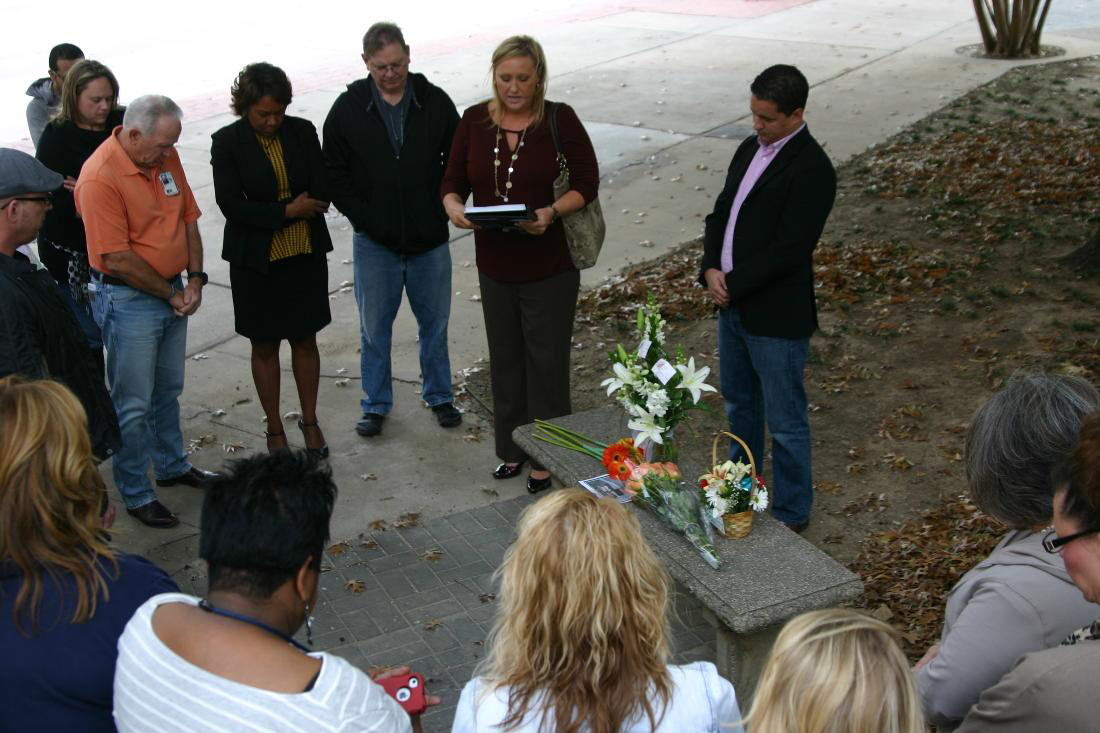Marty Wilson’s friends would never have known what happened to him except for Driss Siyas.
Siyas, owner of the Casablanca Coffee shop, counted himself as a close friend of the gentle homeless man who spent much of the last five years of his life hanging out at the Fritz G. Lanham Federal Building across the street.
“We met in 2008. He would come ask for food [at Casablanca Coffee]. I said, no problem. He was a very nice person, a sad person,” Siyas said. “He never hurt anyone.”
When Wilson stopped showing up, his friends went looking for him. Siyas eventually learned from a customer that Martin Matthew Wilson, 57, had died at Arlington Heights Health and Rehabilitation Center on Nov. 27, three weeks earlier. Because they weren’t family, his friends couldn’t find out the details of Wilson’s death, but only that he had died of “natural causes” –– that is, he wasn’t murdered, didn’t overdose on drugs, didn’t commit suicide.
Now Siyas worries about the countless other homeless people who struggle outside Fort Worth’s system of shelters and helping agencies.
“We need to fix this problem before it’s too late,” he said. “Marty, he’s gone now, but more people need help.”
The reality is, however, that for people like Wilson, who avoid the shelters and who won’t voluntarily seek or submit to mental healthcare, there is no easy fix.
“If someone wants to refuse treatment, they can,” said Natasha Lawry, a friend of Siyas. She’s a caseworker for Court-Appointed Special Advocates of Tarrant County (CASA), a volunteer organization that advocates for abused and neglected children.
“We live in a free society, and Marty was free to do as he wished,” she said. “Perhaps he didn’t want treatment.”
Wilson spent time at the Presbyterian Night Shelter, according to his friends, but didn’t like going there.
“He didn’t feel safe,” said Carmen Drake. “He said he had his clothes stolen, and arguments [among residents] would frighten him. He said he’d rather sleep outside. And that’s why they [people in Wilson’s situation] die.”
Healthcare officials couldn’t discuss Wilson’s records with Fort Worth Weekly due to privacy restrictions, but several mental health professionals said his symptoms were in line with the mental disorder known as schizophrenia. People with that disorder suffer from hallucinations, delusions, and disordered thinking.
Persons with mental health problems tend to be sensitive to their environment, and many of them avoid shelters, Sue Adams said. She is an office manager at the National Alliance on Mental Illness, the nation’s largest grassroots mental health organization.
“If they have schizophrenia, they are out of touch with reality,” she said. “They may hear voices and have a fear of other people. That would be why they would be reluctant to seek help, but if you can build a relationship of trust, then they are more likely to [accept] help.”
According to information on the city’s Directions Home website, about 13 percent of the city’s homeless were identified in 2013 as “severely mentally ill.” Directions Home is a city-led 10-year plan to seriously reduce chronic homelessness. Information from the Tarrant County Homeless Coalition suggested that only a small percentage of the homeless mentally ill avoid the shelter system and social services, but the numbers aren’t clear. The coalition is a government agency that coordinates resources and develops strategies to end homelessness.
“These are folks who have a range of social issues that they are dealing with,” said Walter Taylor, director of housing services at Mental Health/Mental Retardation of Tarrant County. “For the homeless in general, 30 percent to 60 percent have a mental illness or substance-use disorder, especially among the chronically homeless. Not having an address or lacking critical documents can be barriers” to proper treatment.
MHMR of Tarrant County manages an outreach team that regularly checks on Tarrant County’s homeless population outside of the shelter system on Lancaster Avenue, providing food, water, clothing, and mental health services.
“If they are suffering from a mental health issue, we will try to engage them in services,” said Catherine Carlton, communication director for the local MHMR agency. “We have a registered nurse who goes out weekly as well to help assess people in the field. Our teams follow up weekly with people who are engaged in services. They also help with supported housing. If someone is not interested in services, the team will follow up again just to make sure and try to engage them one more time.”
MHMR of Tarrant County provides supportive housing for homeless men and women with serious mental health disorders as well as treatment, through seven outpatient clinics located in and around Fort Worth, but they can only provide treatment if the patient is willing to receive it.
In some situations, concerned friends or others can seek a mental health warrant that allows a medical facility to forcibly retain and treat the individual. A county official who asked not to be named said that on rare occasions, mentally ill people who cannot take care of themselves can be treated in that manner, but it’s a difficult standard to prove legally.
“It’s a civil warrant,” said Ronald Parra, programs specialist at MHMR of Tarrant County. “Anyone can file it, not just family members. The [mentally ill] person has to be a danger to themselves or others or so psychotic that they can’t take care of themselves. Often, these people have made a threat or an overt action [indicating a threat].”
Parra said that if a warrant is approved by a justice of the peace, the next step is for a deputy sheriff to pick up the individual and take him or her to a hospital for treatment. From there, the hospital has discretion on treatment and even how long to retain the individual.
If someone appears mentally ill but doesn’t display threatening behaviors, the legal path to forced treatment is long and complicated, Lawry said. “If someone wants to refuse treatment, the legal standard you’d have to reach to have them declared mentally incompetent is almost insurmountable.”
The treatment process can be easier when relatives are available to advocate for mentally ill individuals, but Wilson’s relatives, if he had any, were not an active part of his life. According to Chris Sciacca, director at Arlington Heights Health and Rehabilitation Center, no family members came to see Wilson during his four days at the center.
“That’s very normal,” said Adams, of the mental illness alliance. “[People like Wilson] tend to pull away from family members, and family members don’t know what to do, so they let them pull away.”
To combat these potential problems, the alliance offers a class each month at University Christian Church in Fort Worth called Family to Family, to teach family members communication skills.
Adams said it’s important to use kindness and respect in dealing with those who have a noticeable mental disorder — it may be the only support they have. “That contact, that ‘You’re OK, and I see you as a human being,’ is so important to them to know they have value. It’s hard for them to see worth in themselves,” she said.
Wilson had that kind of contact, judging by the stories told by his friends. They described him as a kind and amiable person whose favorite perch was a bench near the main entrance to the Lanham Building. He didn’t ask for money, but he talked to many of those who came along.
“He thought the FBI owed him money,” said Mark Maxwell, an employee of the Lanham Building and close friend of Wilson. “He said a ‘Special Agent Decker’ owed him money he earned as a confidential informant. He meant no harm, but he was a bit agitated, and he could worry people.” (A Special Agent Decker was a frequent character on the popular television series NCIS.)
His friends had begun to notice that Wilson was experiencing problems with his physical health before he disappeared in November.
“As he became ill, he would start lying down,” said Giselle Romero, logistics director at U.S. General Services Administration in the Lanham Building. She noticed the change in September.
“That’s when we started to worry,” said Dan Scholl, who also works in logistics for the GSA. “Then we didn’t see him again.”
When Wilson’s body went unclaimed, it was cremated under county guidelines and the remains buried at the Skyvue Memorial Gardens in the Garden of Serenity in Mansfield.
Siyas and Lawry organized a memorial service for him on Dec. 19, outside the Lanham Building. About 30 people took part.
“It’s excellent to see everyone,” Lawry said at the beginning of the service. “It’s really heartwarming. Hopefully, you’ll share your stories [about Wilson]. Driss felt deeply about Marty. I have a prayer for Marty and the other homeless.”
And indeed, Wilson’s friends stayed and told stories about their departed friend for several minutes.
Several said that Wilson talked so fast in his agitation that people often couldn’t catch what he was saying.
“People had a hard time understanding him,” said Siyas. “I understood the language of his heart.”
Fort Worth freelance writer Edward Brown can be reached at ejb0017@yahoo.com.













Thank you Federal Judges for this, prior to one of those bleeding heart libotards, these people were kept safe and received medication…but Judge Idiot decided they were being harmed so he turned them loose and now they die by hundreds due to not being able to get/seek help due to their issues…sometimes Judges are a bigger burden than taxes